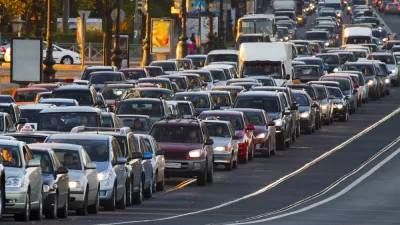New data released by the Federal Highway Administration shows that vehicle mile traveled increased three percent for the first nine months of 2016 compared to the same period last year. Driving has increased continuously since April 2014.

"The new data, published in FHWA’s latest 'Traffic Volume Trends' report – a monthly estimate of U.S. road travel — show that more than 265.5 billion miles were driven in September 2016 alone which is a 2.9 percent increase over the previous September," reports Doug Hecox for the Federal Highway Administration.
When seasonally-adjusted ("which is conducted by USDOT’s Bureau of Transportation Statistics as a way to even out seasonal variation in travel and enable vehicle miles travelled comparisons with any other month in any year"), the September increase drops to 2.4 percent. The adjusted increase over August 2016 was .4 percent.
The September 2016 Traffic Volume Trends report includes a map and chart showing the changes by regions. All five regions saw increases, with the West experiencing the largest at 5.5 percent, and the North-East and North-Central increasing the least, at 1.7 percent and 1.6 percent, respectively.
Vehicle miles travel increase and population growth
Planning agencies might set a goal of keeping VMT increase to a percentage of population growth, bearing in mind that the population would need to be adjusted for those who are at least 16 years of age. The American Public Transit Association points out in a 2009 report [PDF] that "from 1970 to 2007, VMT grew by 168 percent while population only grew by 48 percent," or 3.5 times as fast. That's slower than the first nine months of the year: VMT grew almost four times faster than total (unadjusted) population growth (about .77 percent).
Ideally metropolitan regions could replicate the smart growth policies enacted by Vancouver, B.C., which increased population while reducing traffic, as noted by Streetsblog USA's Angie Schmitt in 2013.
See the Planetizen post on driving totals for the first six months of 2016, which had increased 3.3 percent. A March post and blog indicate that 2015 broke what was thought to be "peak driving" record set in 2007. A January 2015 post noted that the increase in VMT in 2014.
FULL STORY: U.S. Drivers Log 2.4 Trillion Miles In First Nine Months of 2016

Florida Considers Legalizing ADUs
Current state law allows — but doesn’t require — cities to permit accessory dwelling units in single-family residential neighborhoods.

Manufactured Crisis: Losing the Nation’s Largest Source of Unsubsidized Affordable Housing
Manufactured housing communities have long been an affordable housing option for millions of people living in the U.S., but that affordability is disappearing rapidly. How did we get here?

Research Shows More Roads = More Driving
A national study shows, once again, that increasing road supply induces additional vehicle travel, particularly over the long run.

EV Chargers Now Outnumber Gas Pumps by Nearly 50% in California
Fast chargers still lag behind amidst rapid growth.

Affordable Housing Renovations Halt Mid-Air Amidst DOGE Clawbacks
HUD may rescind over a billion dollars earmarked for green building upgrades.

Has Anyone at USDOT Read Donald Shoup?
USDOT employees, who are required to go back to the office, will receive free parking at the agency’s D.C. offices — flying in the face of a growing research body that calls for pricing parking at its real value.
Urban Design for Planners 1: Software Tools
This six-course series explores essential urban design concepts using open source software and equips planners with the tools they need to participate fully in the urban design process.
Planning for Universal Design
Learn the tools for implementing Universal Design in planning regulations.
City of Moreno Valley
Institute for Housing and Urban Development Studies (IHS)
City of Grandview
Harvard GSD Executive Education
NYU Wagner Graduate School of Public Service
City of Cambridge, Maryland
Newport County Development Council: Connect Greater Newport





























